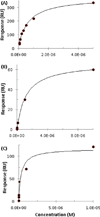A single mouse monoclonal antibody, E58 modulates multiple IgE epitopes on group 1 cedar pollen allergens
- PMID: 27174188
- PMCID: PMC4899245
- DOI: 10.1016/j.molimm.2016.04.006
A single mouse monoclonal antibody, E58 modulates multiple IgE epitopes on group 1 cedar pollen allergens
Abstract
We recently described a dominant role for conformational epitopes on the group 1 allergen of the mountain cedar (Juniperus ashei, Cupressaceae), Jun a 1, in pollen hypersensitivity in South Central U.S.A. Since these epitopes are surface exposed and are likely to be flexible, they may be susceptible to molecular or physical perturbations. This may make Jun a 1 a potential target for new forms of therapy for cedar pollinosis. Here, we describe a mouse monoclonal antibody, termed E58, which binds to the group 1 allergens of the cedar pollens from three highly populated regions of the world (central U.S.A., France and Japan). Upon binding to these allergens, E58 strongly reduces the binding of patient's IgE antibodies to these dominant allergens. This characteristic of E58, and potentially other similar antibodies, suggests an opportunity to develop preventative or therapeutic agents that may inhibit cedar pollen sensitization or prevent their allergic reactions.
Keywords: Allergen structure; Cedar pollen allergy; Conformational epitope; IgE epitope; Jun a 1; Monoclonal antibody.
Copyright © 2016 Elsevier Ltd. All rights reserved.
Conflict of interest statement
The authors declare no conflict of interest.
Figures




Similar articles
-
Mapping of conformational IgE epitopes with peptide-specific monoclonal antibodies reveals simultaneous binding of different IgE antibodies to a surface patch on the major birch pollen allergen, Bet v 1.J Immunol. 2011 May 1;186(9):5333-44. doi: 10.4049/jimmunol.1000804. Epub 2011 Mar 30. J Immunol. 2011. PMID: 21451110
-
Analysis of conformational and sequential IgE epitopes on the major allergen Cry j 2 of Japanese cedar (Cryptomeria japonica) pollen in humans by using monoclonal antibodies for Cry j 2.J Clin Immunol. 2013 Jul;33(5):977-83. doi: 10.1007/s10875-013-9880-7. Epub 2013 Mar 16. J Clin Immunol. 2013. PMID: 23504147
-
Identification of a sequential B-cell epitope on major allergen (Cry j 1) of Japanese cedar (Cryptomeria japonica) pollen in mice.Int Arch Allergy Immunol. 2000 Nov;123(3):228-35. doi: 10.1159/000024448. Int Arch Allergy Immunol. 2000. PMID: 11112859
-
Spectrum of allergens for Japanese cedar pollinosis and impact of component-resolved diagnosis on allergen-specific immunotherapy.Allergol Int. 2015 Oct;64(4):312-20. doi: 10.1016/j.alit.2015.05.008. Epub 2015 Jul 3. Allergol Int. 2015. PMID: 26433527 Review.
-
Mountain cedar allergy: A review of current available literature.Ann Allergy Asthma Immunol. 2022 Jun;128(6):645-651. doi: 10.1016/j.anai.2021.09.019. Epub 2021 Sep 25. Ann Allergy Asthma Immunol. 2022. PMID: 34582944 Review.
Cited by
-
Design of peptides with high affinity binding to a monoclonal antibody as a basis for immunotherapy.Peptides. 2021 Nov;145:170628. doi: 10.1016/j.peptides.2021.170628. Epub 2021 Aug 16. Peptides. 2021. PMID: 34411692 Free PMC article.
-
Molecular patterns in the isotype-specific antibody responses to the major cedar aeroallergen Jun a 1.Mol Immunol. 2018 Sep;101:527-530. doi: 10.1016/j.molimm.2018.08.007. Epub 2018 Aug 29. Mol Immunol. 2018. PMID: 30170300 Free PMC article.
-
Peptide immunotherapy for aeroallergens.Allergy Asthma Proc. 2023 Jul 1;44(4):237-243. doi: 10.2500/aap.2023.44.230028. Allergy Asthma Proc. 2023. PMID: 37480199 Free PMC article.
References
-
- Fuller SA, Takahashi M, Hurrell JG. Fusion of myeloma cells with immune spleen cells. Curr. Protoc. Mol. Biol. 2001;Chapter 11(Unit 11) - PubMed
-
- Gibson DG, Young L, Chuang RY, Venter JC, Hutchison CA, III, Smith HO. Enzymatic assembly of DNA molecules up to several hundred kilobases. Nat. Methods. 2009;6:343–345. - PubMed
Publication types
MeSH terms
Substances
Grants and funding
LinkOut - more resources
Full Text Sources
Other Literature Sources
Medical
Miscellaneous

